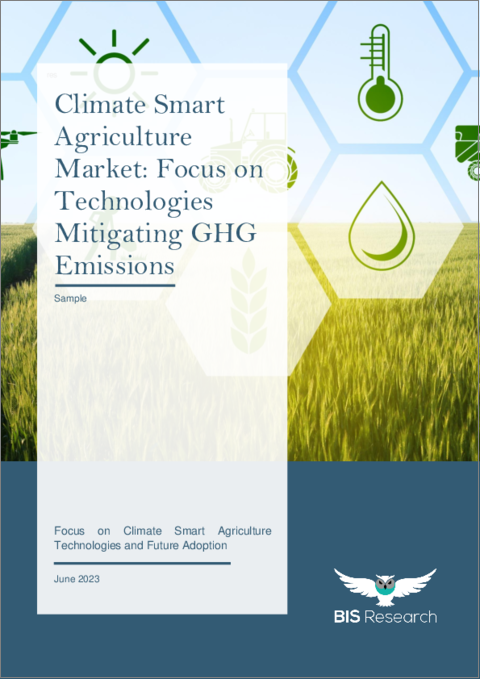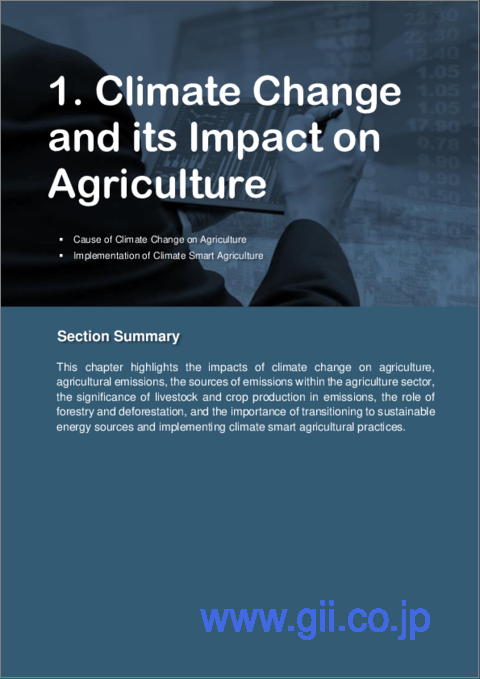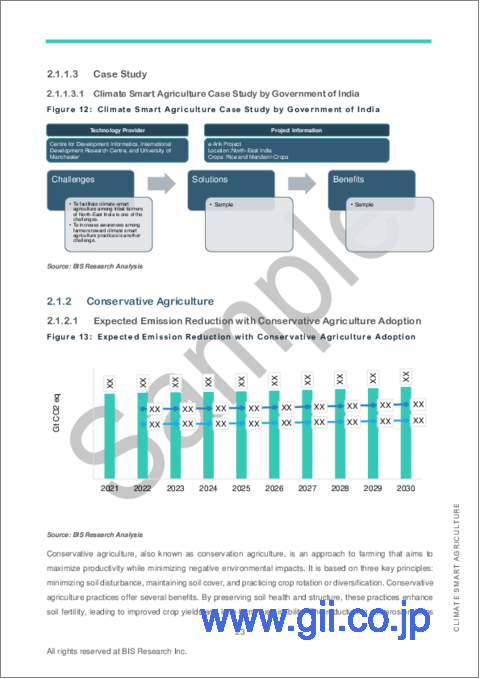|
|
市場調査レポート
商品コード
1308025
CSA (気候変動対応型農業) 市場:GHG排出削減技術への注目Climate Smart Agriculture Market - Focus on Technologies Mitigating GHG Emissions |
||||||
カスタマイズ可能
|
|||||||
| CSA (気候変動対応型農業) 市場:GHG排出削減技術への注目 |
|
出版日: 2023年07月04日
発行: BIS Research
ページ情報: 英文 93 Pages
納期: 1~5営業日
|
- 全表示
- 概要
- 図表
- 目次
気候変動、食糧安全保障、農業慣行には複雑な関係があり、この多面的な課題に取り組むためには、農家、政策立案者、研究者らが協力し合う必要があります。
これらのステークホルダーは、排出量の削減、気候回復力・適応力の強化、農業生産性の向上を同時に実現する戦略を積極的に展開しています。CSAの導入は、このプロセスに内在する相乗効果とトレードオフを考慮しながら、相互に関連するこれらの目標を効果的に追求する包括的なアプローチとして浮上しています。
当レポートでは、CSA (気候変動対応型農業) の市場を調査し、気候変動と農業への影響、CSA関連の各種技術の情勢、各ステークホルダーへの提言、将来のロードマップなどをまとめています。
目次
第1章 気候変動と農業への影響
- 農業における気候変動の原因
- ファームゲート排出
- 林業
- エネルギー利用
- CSAの導入
第2章 CSA (気候変動対応型農業):技術情勢
- 精密農業
- 精密農業の導入により期待される排出削減量
- 保守的な農業
- 農林業
- 家畜管理
- 再生可能エネルギー
- 水管理
- 気候情報サービス
- 政府の主な取り組みとその影響
- 世界の資金供給
- 政府の資金投入
- 民間資金
- CSA導入における主な課題
- 高額な初期費用
- インフラとCSAのメリットに対する認識の不足
第3章 提言・結論
- 政策立案者への提言
- 技術プロバイダーへの提言
- 総論:将来のロードマップ
第4章 調査手法
List of Figures
- Figure 1: Three Objectives of Climate Smart Agriculture
- Figure 2: Major Sectors of GHG Emissions in Agriculture
- Figure 3: Climate Smart Agriculture Techniques
- Figure 4: Factors Catalyzing the Growth of Climate Smart Agriculture Adoption
- Figure 5: Global Greenhouse Gas Emissions on Agriculture
- Figure 6: World Farm-Gate Emissions by Activity
- Figure 7: Yearly Cattle Population (2018-2026)
- Figure 8: Global Deforestation and Forest Growth Over 30 Years (1990-2020)
- Figure 9: Steps for the Implementation of Climate Smart Agriculture
- Figure 10: Expected Emission Reduction with Precision Agriculture Adoption
- Figure 11: Precision Agriculture Technologies Emission Reduction Potential
- Figure 12: Patents Filed or Granted for Precision Agriculture Technology (Global), January 2018-December 2022
- Figure 13: Climate Smart Agriculture Case Study by Government of India
- Figure 14: Monarch Tractor Wente Vineyards Energy Case Study
- Figure 15: Yield Monitoring and Digitization Case Study
- Figure 16: Expected Emission Reduction with Conservative Agriculture Adoption
- Figure 17: Conservative Agriculture Technologies Emission Reduction Potential
- Figure 18: Patents Filed or Granted for Conservative Agriculture (Global), January 2018-December 2022
- Figure 19: Soil Erosion Case Study
- Figure 20: Sustainable Agriculture Land Management Case Study
- Figure 21: Expected Emission Reduction with AgroForestry Adoption
- Figure 22: Agroforestry Technologies Emission Reduction Potential
- Figure 23: Patents Filed or Granted for Agroforestry (Global), January 2018-December 2022
- Figure 24: Climate Smart Forestry Case Study - Wageningen University & Research
- Figure 25: Expected Emission Reduction with Livestock Management Technologies Adoption
- Figure 26: Livestock Management Technologies Emission Reduction Potential
- Figure 27: Patents Filed or Granted for Livestock Management (Global), January 2018-December 2022
- Figure 28: Mongolia Livestock Farming Case Study
- Figure 29: Livestock Monitoring and Management Case Study
- Figure 30: Expected Emission Reduction with Renewable Energy Technology Adoption
- Figure 31: Renewable Energy Technologies Emission Reduction Potential
- Figure 32: Patents Filed or Granted for Renewable Energy (Global), January 2018-December 2022
- Figure 33: Solar Power-Based Microgrid Case Study
- Figure 34: Solar Powered Farm Case Study
- Figure 35: Expected Emission Reduction with Water Management Technology Adoption
- Figure 36: Water Management Technologies Emission Reduction Potential
- Figure 37: Patents Filed or Granted for Water Management (Global), January 2018-December 2022
- Figure 38: Reduction of Input Resources - Zerynth S.p.A. Case Study
- Figure 39: Automated Water and Fertilizer Management Case Study
- Figure 40: Yield Monitoring and Water Management Case Study
- Figure 41: Patents Filed or Granted for Climate Information Services (Global), January 2018-December 2022
- Figure 42: Severe Weather Case Study
- Figure 43: Mongolia Herd Management Climate Information Services Case Study
- Figure 44: Government Funding (by Year-on-Year), January 2021-June 2023
- Figure 45: Funding Analysis, January 2021- June 2023
- Figure 46: Funding Analysis, January 2020 - June 2023
- Figure 47: Funding Analysis (by Technology), 2020-2022
- Figure 48: Building Blocks for CSA Policy Implementation at Country Level
- Figure 49: Global Climate Smart Agriculture Market: Focus on Technologies Mitigating GHG Emissions: Research Methodology
List of Tables
- Table 1: Tools to Track Carbon Emissions in Agriculture
- Table 2: Key Technologies and Providers
- Table 3: Key Precision Agriculture Companies
- Table 4: Key Technologies and Providers
- Table 5: Key Conservative Agriculture Solution Providers
- Table 6: Key Technologies and Providers
- Table 7: Key Agroforestry Technology Providers
- Table 8: Key Technologies and Providers
- Table 9: Key Livestock Management Providers
- Table 10: Key Technologies and Providers
- Table 11: Key Renewable Energy Solution Providers
- Table 12: Key Technologies and Providers
- Table 13: Key Water Management Solution Providers
- Table 14: Key Technologies and Providers
- Table 15: Key Climate Information Services Providers
- Table 16: Key Government Initiatives/Programs
- Table 17: Key Government Fundings Focusing Climate Smart Agriculture Practices
- Table 18: Key Private Fundings Focusing on Climate Smart Agriculture Practices
- Table 19: Key Active Investors in Climate Smart Agriculture Market, 2022
- Table 20: Estimated Investment Costs and Service Contracts for Precision Agriculture Technologies
“BIS Research Study Highlights Climate Smart Agriculture Market.”
Introduction
The intricate relationships between climate change, food security, and agricultural practices underscore the need for collaborative endeavors among farmers, policymakers, and researchers to tackle this multifaceted challenge. These stakeholders are actively deploying strategies that concurrently mitigate emissions, enhance climate resilience and adaptation, and improve agricultural productivity. The adoption of climate smart agriculture (CSA) practices has emerged as a comprehensive approach to effectively pursue these interconnected objectives, taking into account the synergies and trade-offs inherent in the process.
Market Introduction
As defined by the United Nations Food and Agriculture Organization (FAO), climate smart agriculture (CSA) is an agricultural framework that offers guidance to farmers in adopting environmentally sustainable and climate resilient practices. This approach goes beyond traditional farming methods and takes an integrated approach to landscape management, including cropland, livestock, forests, and fisheries. It aims to effectively address the interconnected issues of food security and climate change. The applicability of CSA extends to countries across both the Global South and Global North, although regional contexts may result in variations in specific challenges and the prioritization of objectives.
Market Challenges:
The implementation of climate smart agriculture practices can pose financial challenges for farmers, as it often involves significant upfront costs associated with acquiring new technologies and infrastructure. Furthermore, the adoption of precision farming techniques requires investments in specialized equipment and training. However, despite these initial financial barriers, it is crucial to provide support for the adoption of climate smart agriculture practices due to their long-term advantages, such as enhanced crop yields and improved environmental sustainability.
Farmers who possess limited practical knowledge about climate smart agriculture (CSA) and are primarily motivated by economic incentives may exhibit reluctance toward adopting CSA practices. This resistance to change or aversion to risk can hinder their willingness to embrace CSA. The lack of practical understanding refers to limited awareness among farmers regarding the environmental consequences associated with conventional agricultural practices and the potential advantages offered by CSA.
The limited connectivity in marginalized areas poses a significant challenge in terms of accessing real-time data, weather forecasts, and market information essential for the effective implementation of climate smart agriculture (CSA) techniques. Bridging the infrastructure gap becomes imperative to ensure equitable access to information and resources, thereby facilitating broader adoption of CSA practices in these underserved regions.
How Can This Report Add Value to an Organization?
Primary Research
The primary sources involve the climate smart agriculture industry experts and stakeholders such as data suppliers, platform developers, and service providers. Respondents such as vice presidents, CEOs, marketing directors, and technology and innovation directors have been interviewed to verify this research study's qualitative and quantitative aspects.
The key data points taken from primary sources include:
- understanding the competitive landscape
- validation of the numbers of various markets for market type
Secondary Research
This research study involves the usage of extensive secondary research, directories, company websites, and annual reports. It also makes use of databases, such as Hoovers, Bloomberg, Businessweek, and Factiva, to collect useful and effective information for an extensive, technical, market-oriented, and commercial study of the global market. In addition to the aforementioned data sources, the study has been undertaken with the help of other data sources and websites, such as www.fao.org and www.worldbank.org.
Secondary research was done to obtain crucial information about the industry's value chain, revenue models, the market's monetary chain, the total pool of key players, and the current and potential use cases and applications.
Table of Contents
1 Climate Change and its Impact on Agriculture
- 1.1 Cause of Climate Change on Agriculture
- 1.1.1 Farm-Gate Emissions
- 1.1.1.1 Livestock
- 1.1.1.2 Crop Production
- 1.1.2 Forestry
- 1.1.3 Energy Use
- 1.1.1 Farm-Gate Emissions
- 1.2 Implementation of Climate Smart Agriculture (CSA)
2 Climate Smart Agriculture - Technology Landscape
- 2.1 Precision Agriculture
- 2.1.1 Expected Emission Reduction with Precision Agriculture Adoption
- 2.1.1.1 Patent Analysis
- 2.1.1.2 Key Technologies and Providers
- 2.1.1.3 Case Study
- 2.1.1.3.1 Climate Smart Agriculture Case Study by Government of India
- 2.1.1.3.2 Monarch Tractor Wente Vineyards Energy Case Study
- 2.1.1.3.3 Yield Monitoring and Digitization Case Study
- 2.1.2 Conservative Agriculture
- 2.1.2.1 Expected Emission Reduction with Conservative Agriculture Adoption
- 2.1.2.2 Patent Analysis
- 2.1.2.3 Key Technologies and Providers
- 2.1.2.4 Case Study
- 2.1.2.4.1 Soil Erosion Case Study
- 2.1.2.4.2 Sustainable Agriculture Land Management Case Study
- 2.1.3 Agroforestry
- 2.1.3.1 Expected Emission Reduction with AgroForestry Adoption
- 2.1.3.2 Patent Analysis
- 2.1.3.3 Key Technologies and Providers
- 2.1.3.4 Case Study
- 2.1.3.4.1 Climate Smart Forestry Case Study - Wageningen University & Research
- 2.1.4 Livestock Management
- 2.1.4.1 Expected Emission Reduction with Livestock Management Technologies Adoption
- 2.1.4.2 Patent Analysis
- 2.1.4.3 Key Technologies and Providers
- 2.1.4.4 Case Study
- 2.1.4.4.1 Mongolia Livestock Farming Case Study
- 2.1.4.4.2 Livestock Monitoring and Management Case Study
- 2.1.5 Renewable Energy
- 2.1.5.1 Expected Emission Reduction with Renewable Energy Technology Adoption
- 2.1.5.2 Patent Analysis
- 2.1.5.3 Key Technologies and Providers
- 2.1.5.4 Case Study
- 2.1.5.4.1 Solar Power-Based Microgrid Case Study
- 2.1.5.4.2 Solar Powered Farm Case Study
- 2.1.6 Water Management
- 2.1.6.1 Expected Emission Reduction with Water Management Technology Adoption
- 2.1.6.2 Patent Analysis
- 2.1.6.3 Key Technologies and Providers
- 2.1.6.4 Case Study
- 2.1.6.4.1 Reduction of Input Resources - Zerynth S.p.A. Case Study
- 2.1.6.4.2 Automated Water and Fertilizer Management Case Study
- 2.1.6.4.3 Yield Monitoring and Water Management Case Study
- 2.1.7 Climate Information Services
- 2.1.7.1 Expected Emission Reduction with Climate Information Services Adoption
- 2.1.7.2 Patent Analysis
- 2.1.7.3 Key Technologies and Providers
- 2.1.7.4 Case Study
- 2.1.7.4.1 Severe Weather Case Study
- 2.1.7.4.2 Mongolia Herd Management Climate Information Services Case Study
- 2.1.1 Expected Emission Reduction with Precision Agriculture Adoption
- 2.2 Key Government Initiatives and Impacts
- 2.3 Global Funding
- 2.3.1 Government Fundings
- 2.3.1.1 Government Fundings (Year-on-Year)
- 2.3.1.2 Government Funding (by Country)
- 2.3.1.3 Key Government Fundings Focusing Climate Smart Agriculture Practices
- 2.3.2 Private Funding
- 2.3.2.1 Funding Analysis (Year-on-Year)
- 2.3.2.2 Funding Analysis (by Technology)
- 2.3.2.3 Key Private Funding Focusing on Climate Smart Agriculture Practices
- 2.3.2.4 Key Investors in Climate Smart Agriculture Market, 2022
- 2.3.1 Government Fundings
- 2.4 Key Challenges in CSA Adoption
- 2.4.1 High Upfront Costs
- 2.4.2 Lack of Infrastructure and Awareness of Climate Smart Agriculture Benefits
3 Recommendation and Conclusion
- 3.1 Recommendation for Policymakers
- 3.2 Recommendation For Technology Providers
- 3.3 Conclusion: Future Road Map
- 3.3.1 Expected Farm Consolidation
- 3.3.2 Government Support
- 3.3.3 Expected Demand for Climate Smart Agriculture Contract Services among Small Farms
- 3.3.4 Growing Millennial Populations in Agriculture
4 Research Methodology
- 4.1 Data Sources
- 4.1.1 Primary Data Sources
- 4.1.2 Secondary Data Sources





